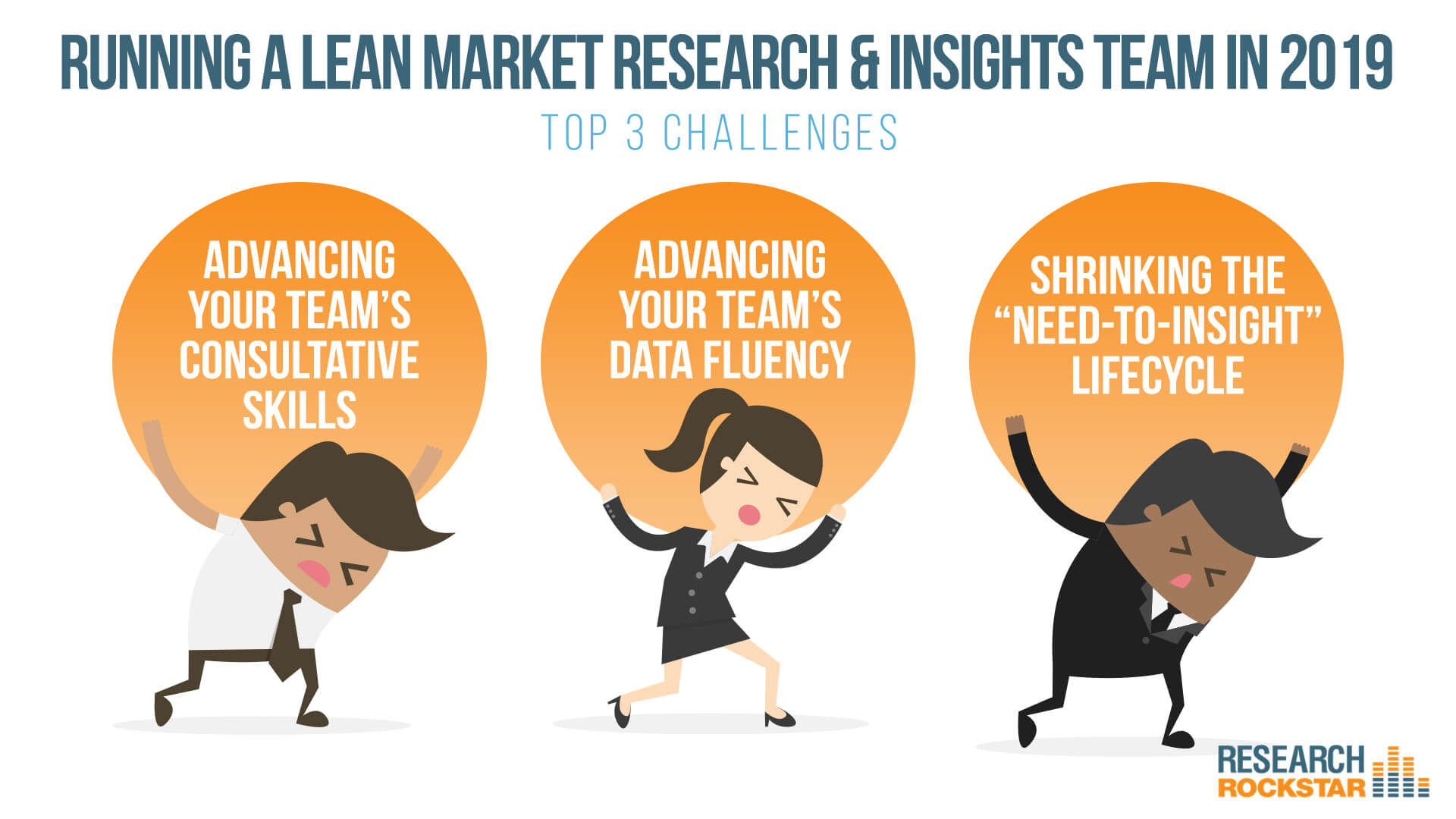Maybe it’s a post-New Year’s bump, maybe it’s the side-effect of end-of-year business plans. In any case, we’re only a few weeks into 2019, and already I’m seeing some interesting trends for those of us in market research & insights. And I bet you are seeing some, too.
By far, the most widespread topic I am hearing about from team leaders in 2019 has been about the realities of running lean. And I don’t mean lean as in “agile” and Kanban boards. I mean lean, as in no fat, limited resources, and what can sometimes feel like precariously few people. Notably, running lean applies to both in-house teams and market research agencies/consultancies (thus, for the purpose of this article, “teams” means all teams—regardless of company type).
Of course, the challenge of running lean isn’t unique to market research & insights teams—it’s an organizational reality for many functional areas (just ask anyone in IT) and industries (just ask anyone in healthcare). And some of the strategies for running lean without burning out your team are also fairly universal, as this article in Inc. Magazine demonstrates (there are many more articles and academic studies on this topic, from many reputable sources).
Running Lean or Understaffed?
Part of the challenge of running lean is that there’s a risk of tipping into being truly understaffed. In some teams, it can be a very fine line and crossing it means insufficient work volume or expertise capacity. Further, various studies have well-documented the negative effects of true understaffing on work quality and employee engagement (see this related article from the Journal of Occupational Health Psychology, What to do and what works? Exploring how work groups cope with understaffing). As a result, many team leaders are deploying strategies to keep them on the “right side” of lean.
3 Challenges to Running Lean in 2019
While the reality of lean teams exists in many professions, market research & insights teams have some unique conflicts that exacerbate the challenges. That’s because some of the big trends for our profession in 2018 continue to be strong in 2019. Specifically, these three:
- Advancing consultative skills
- Advancing data fluency
- Shrinking the “need-to-insight” lifecycle
Running lean while achieving such notable advances is no mean feat. Let’s take a closer look at how some team leaders are doing so.
Advancing the team’s consultative skills
This leader is upskilling their team’s ability to be more consultative (whether during strategic planning, methodology design, data analysis or deliverables creation phases of work). Success with this initiative requires that team members attain meaningful knowledge about the marketing or other business functions they are ultimately supporting. This initiative is especially evident in teams that are seeking to have a leadership role as a trusted data advisor (see this video about McKinsey’s related prediction and another video about related implications for market researchers).
Advancing the team’s data fluency
This team leader is expanding the team’s data fluency. That is, the ability to leverage for insights purposes the many data sources that are now widely available to most organizations. In 2018, I watched some great teams (again, both in-house and consultancy) expand well beyond their methodology comfort zones. In some cases, this was the fundamental shift from being focused on primary research methods (surveys, focus groups, etc.), to also working successfully with multiple data sources (including 1st, 2nd and 3rd party data).
Shrinking the “need-to-insight” lifecycle
Fast is always getting faster. Let’s define the “need-to-insight” lifecycle as starting the day the need for research and analysis is identified, and ending the day our awesome, insight-igniting results are delivered. Many teams are working to continue shrinking the cycle in order to meet client (internal or external) demand. Thus, many team leaders are running lean…and fast!
What are the options for running lean while making significant advances?
For some market research and insights team leaders, all three of these initiatives are important, and in many cases are also high-visibility within their organizations. And accomplishing them while running lean certainly adds to the challenge! Which begs the question: what options exist to balance these initiatives as best as possible, while running lean?
One option: automation. Different teams choose different levels of automation investment. This seems to vary by team size and leadership’s automation POV. For some teams, the goal is to maximize automation, and save the human brains for the consultative-level work. For others, the investment is more measured.
While technology (automation) is certainly part of the equation, so are people.
So, what are the “people” options for running lean while pursuing important advances? One option being employed by many teams is an increased (or updated) use of high-value partnerships. In effect, using partnerships to gain just-in-time, fluid access to data fluency and consultative skills and other areas of expertise (high-end data analytics, application specialties, etc.). Sure, one could say this is the same outsourcing, but the “flavor” seems different these days—much more collaborative, more cross-functional, more fluid.
Rethinking what any team does directly, versus what it delegates to partners, can help teams run lean while focusing on key initiatives. And it can also create new ways for in-house insights teams and consultancy teams to collaborate and advance our mutual work (we’re better together). Indeed, this sometimes flips conventional “client” and “supplier” roles in interesting ways, as the person contributing a specific skill or data source could be (and increasingly is) employed as either an in-house or as a provider-side professional.
Optimized partnership strategies can also mitigate the risk of tipping over from “running lean” to being understaffed. Which, again, applies to all teams.
Best Practices for Leveraging Market Research & Insights Partners Varies…a lot!
Clearly, teams use partnerships to varying levels and for varying purposes. While the partnership decision rules can be specified in many ways, here are a few options:
- By methodology or data source. For example, some consultancies execute 3-5 methodologies in-house, and have partners for other just-in-time expertise needs. The rule here becomes a decision about how broad the team’s on-staff expertise should be. Should the team be generalists? Specialists? What’s the right mix?
- By project type. Does the team excel at some insights-related projects more than others? I know one in-house insights team that executes all customer experience and feedback projects, but has trusted partners for pretty much everything else.
- By project phase. For example, is the team awesome at methodology planning and execution, but maybe not at synthesis and reporting (or vice versa)? One option, of course, is to train them on those skills (yes, I am biased on this point!). Another is to get help as needed.
Rethinking Partnerships for Expertise & Capacity Needs
It is an important conversation for many teams that are running lean while making important advances: can rethinking partnership roles (and rules) turn the challenge into an opportunity? Can partnerships help the team advance its consultative and data fluency skills or help reduce to need-to-insight lifecycle?
The good news: there is no shortage of qualified market research and insights providers (though certainly the process of finding and qualifying great ones takes time). Consultants, full-service agencies, specialty consultancies and various other providers offer various broad and deep areas of expertise.Whether the team needs a syndicated media data specialist, a brilliant reporter, a segmentation specialist, a 3rd party data integrator or something else….they are out there!
Top 5 Points for Market Research & Insights Team Leaders
If you are running a lean team, you are busy and likely skimming more than reading. So here are my top 5 points that team leaders may find helpful in planning their 2019 leadership activities:
- Running lean in 2019 is a widespread reality for both in-house and supplier teams.
- Running lean is not the same thing as being understaffed. Though I know some teams that are dancing on that edge!
- Running lean is hard—many managers are expected to “run lean” while also advancing their team’s consultative and data fluency skills and shrinking the need-to-insight lifecycle.
- Options for balancing these seemingly conflicting initiatives include training, automation and re-optimizing use of partnerships.
- When re-optimizing use of partnerships, take the opportunity to also rethink your partnership delegation rules.
[P.S. I am eager for any and all feedback, differences of opinion and questions. Please feel free to contact me at [email protected], or make an appointment for a 20-minute chat here].












